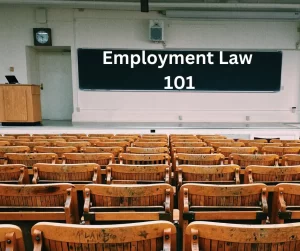
IMPORTANT: This article is for informational purposes only and is based upon my point of view. Due to the rapidly changing nature of the law, we make no warranty or guarantee concerning the accuracy or reliability of the content in this article. No content on this site, regardless of date, should ever be used as a substitute for direct legal advice from your attorney. Please review our Disclaimer|Terms of Use|Privacy Policy before proceeding.

(CAVEAT: This article will only address claims under the Washington Law Against Discrimination, RCW 49.60. However, there are other laws (both state and federal) that might support a claim of wrongful termination.)
What is the Statute of Limitations for Wrongful Termination in WA?
answer:
In Washington State, the statute of limitations for commencing* a wrongful-termination lawsuit in a state court, under the Washington Law Against Discrimination** (WLAD), is 3 years pursuant to RCW 4.16.080(2). See Lewis v. Lockheed Shipbuilding and Const. Co.***, 36 Wn.App. 607, 676 P.2d 545 (Wash.App. Div. 1 1984). However, there could also be earlier deadlines.
(Warning: It can be a complicated and difficult process to determine when the statute of limitations begins to run for individual WLAD claims, and an improper determination can bar both claims for administrative relief (see below) and prospective lawsuits (see above). Therefore, the reader is strongly encouraged to contact an employment attorney to determine both the statute of limitations and when it begins to run for individual WLAD claims — please see our DISCLAIMER.)
_____
* NOTE: The link will take the reader to our Williams Law Group Blog — an external website.
** NOTE: The link will take the reader to an external, governmental website.
*** NOTE: The link will take the reader to our Washington Employment Law Digest blog – an external website.
Administrative Agencies (WSHRC & EEOC):
Generally, the jurisdictional time limitation for filing wrongful-termination complaints through administrative agencies such as the Washington State Human Rights Commission* (WSHRC) and the U.S. Equal Employment Opportunity Commission* (EEOC) is significantly shorter; however, this topic is beyond the scope of this article — speak to an attorney for more information. See “Warning,” above.
_____
* NOTE: The link will take the reader to an external, governmental website.
Other Relevant Laws:
Other employment laws (both state and federal) might also support a claim of “wrongful termination” in Washington State including, but not limited to the following:
→ Washington State Common Law (Wrongful Termination in Violation of Public Policy*)
→ Title VII of the Civil Rights Act of 1964 (when the termination is discriminatory, based on a protected class)
→ Section 1981 (42 U.S.C. §1981*) (when the termination supports a viable legal theory of racial discrimination)
Talk to an attorney to determine the statute of limitations for relevant state and federal laws. See “Warning,” above.
_____
* NOTE: The link will take the reader to our Williams Law Group Blog — an external website.
Additional Information:
A “statute of limitations” is “[a] law that bars claims after a specified period; specif., a statute establishing a time limit for suing in a civil case, based on the date when the claim accrued (as when the injury occurred or was discovered).” Black’s Law Dictionary 1451 (Deluxe 8th ed. 2004). “The purpose of such a statute is to require diligent prosecution of known claims, thereby providing finality and predictability in legal affairs and ensuring that claims will be resolved while evidence is reasonably available and fresh.” Id. The Washington State statute concerning limitation of actions is contained under chapter 4.16 RCW.
READ OUR RELATED ARTICLES
We invite you to read more of our articles related to this topic:
» Constructive Discharge in WA State**
» Effective Date For Constructive Discharge (WA State)
» Employment Law 101: Statute of Limitations
» Retaliatory Discharge (WA State)
» EEOC: The Notice of Right to Sue
» Title VII of the Civil Rights Act of 1964
» WA State Human Rights Commission Complaints
» WA State Human Rights Commission: Functions, Powers, and Duties
» WA State Torts: Wrongful Termination in Violation of Public Policy**
» WLAD Statute of Limitations: Equitable Tolling
**NOTE: This link will take you to our Williams Law Group Blog, an external website.
NEED HELP?
If you need legal assistance, consider contacting an experienced attorney to discuss your case. This article is not offered as legal advice and will not establish an attorney-client relationship with Law Office of Gregory A. Williams, or the author of this article; please refer to our Disclaimer | Terms of Use | Privacy Policy for more information.




